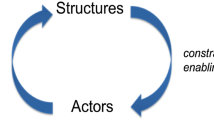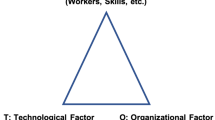Abstract
Resilience is a topic widely discussed in the system safety community yet with various conceptualizations which have not been fully converged in principle. Characterization of resilience of socio-technical systems is then left open to be interpreted by alternative means. As one of the means, coordinated control theory (CCT) can explain a mechanism that enables the systems to achieve adaptations constantly in response to consecutive disturbances and changes. This article presents a theoretical viewpoint for depicting continuity of a system’s resilient performance, based on coordinated control, as understanding of safety degradation and accident incubation in socio-technical systems. The theoretical viewpoint was exemplified, via preliminary analysis of resilient processes in the practical context of combining air crash LNI610, Lion Air, Indonesia, 2018 and its pre-accident story. This article also demonstrates the potential that the CCT view of resilience supports the high reliability organization (HRO) theory, by conceptually visualizing the HROs’ characteristics that have been well grounded in empirical observations, and comparing the visualized state space models that describe HROs and regular organizations respectively. The CCT insights into resilient performance and processes of a system/organization make theoretical sense how to maintain system states aligned with coordinated control principles, thereby enhancing the system’s capacity for adapting to a dynamic and uncertain work environment. Future research will focus on refining the proposed framework for descriptions of input/output behaviors of the resilient systems, as well as addressing self-organization contributing to growth of the systems’ adaptive capacity.





Similar content being viewed by others
References
Amir S, Kant V (2018) Sociotechnical resilience: a preliminary concept. Risk Anal 38(1):8–16
Aven T, Renn O (2009) On risk defined as an event where the outcome is uncertain. J Risk Res 12(1):1–11
Braithwaite J, Wears RL, Hollnagel E (2015) Resilient health care: turning patient safety on its head. Int J Qual Health Care 27(5):418–420
Branlat M, Woods DD (2010) How do systems manage their adaptive capacity to successfully handle disruptions? A resilience engineering perspective. In: 2010 AAAI fall symposium series
Briske DD, Bestelmeyer BT, Stringham TK, Shaver PL (2008) Recommendations for development of resilience-based state-and-transition models. Rangel Ecol Manag 61(4):359–367
Cao S, Tu X (2016) Research and development of multi-variable coordinated control theory. J Syst Sci Math Sci 36(9):1476–1486
Carlson JM, Doyle J (2002) Complexity and robustness. Proc Natl Acad Sci 99(suppl 1):2538–2545
Costella MF, Saurin TA, Guimarães L (2009) A method for assessing health and safety management systems from the resilience engineering perspective. Saf Sci 47(8):1056–1067
Cote M, Nightingale AJ (2012) Resilience thinking meets social theory: situating social change in socio-ecological systems (SES) research. Prog Hum Geogr 36(4):475–489
Dekker S (2004) Ten questions about human errors: a new view of human factors and system safety. CRC Press, Boca Raton
Dekker S, Pruchnicki S (2014) Drifting into failure: theorizing the dynamics of disaster incubation. Theor Issues Ergon Sci 15(6):534–544
Dekker S, Woods DD (2010) The high reliability organization perspective. In: Salas E, Maurino D (eds) Human factors in aviation, 2nd edn. Wiley, New York, pp 123–146
Dulac N (2007) A framework for dynamic safety and risk management modeling in complex engineering systems. Ph.D. dissertation, Massachusetts Institute of Technology, Boston, MA
Enjalbert S, Vanderhaegen F (2017) A hybrid reinforced learning system to estimate resilience indicators. Eng Appl Artif Intell 64:295–301
Flemisch F, Abbink D, Itoh M, Pacaux-Lemoine MP (2019) Special issue on shared and cooperative control. Cogn Technol Work 21:553–554
Folke C, Carpenter S, Elmqvist T, Gunderson L, Holling CS, Walker B (2002) Resilience and sustainable development: building adaptive capacity in a world of transformations. AMBIO J Hum Environ 31(5):437–440
Francis R (2013) Analysis of resilience in manmade and natural systems. In: Resilience2050.eu: new design principles fostering safety, agility and resilience for ATM
Gao J, Dekker S (2017) Concepts and models of safety, resilience, and reliability. In Surgical patient care. Springer, Cham, pp 25–37
Haavik TK, Antonsen S, Rosness R, Hale A (2019) HRO and RE: a pragmatic perspective. Saf Sci 117:479–489
Hodgson D, McDonald JL, Hosken DJ (2015) What do you mean, ‘resilient’? Trends Ecol Evol 30(9):503–506
Hale A, Heijer T (2006) Defining resilience. In: Hollnagel E, Wood DD, Leveson NG (eds) Resilience engineering: concepts and precepts. Ashgate, Aldershot, pp 35–40
Hall PA, Lamont M (eds) (2013) Social resilience in the neoliberal era. Cambridge University Press, Cambridge
Hollnagel E (2009) The four cornerstones of resilience engineering. In: Nemeth CP, Hollnagel E, Dekker S (eds) Resilience engineering perspectives: preparation and restoration. Ashgate, Burlington, pp 117–133
Hollnagel E (2012) FRAM: the functional resonance analysis method: modelling complex socio-technical systems. CRC Press, Boca Raton
Hollnagel E (2017) Safety-II in practice: developing the resilience potentials. Routledge, London
Hollnagel E, Woods DD, Leveson NG (2006) Resilience engineering: concepts and precepts. Ashgate, Aldershot
Hopkins A (2014) Issues in safety science. Saf Sci 67:6–14
Howe A, Smajdor A, Stöckl A (2012) Towards an understanding of resilience and its relevance to medical training. Med Educ 46(4):349–356
Jackson S, Ferris TL (2013) Resilience principles for engineered systems. Syst Eng 16(2):152–164
Kervern GY, Louisot JP (2014) Brief overview of Cindynics. In: Louisot JP, Ketcham C (eds) Enterprise risk management. Wiley, Chichester, pp 48–56
La Porte TR, Consolini P (1991) Working in practice but not in theory: theoretical challenges of high reliability organizations. J Public Adm Res Theory 1(1):19–47
La Porte TR (1996) High reliability organizations: unlikely, demanding and at risk. J Conting Crisis Manag 4(2):60–71
Le Coze JC, Dupre M (2006) How to prevent a normal accident in a high reliable organization? The art of resilience, a case study in the chemical industry. In: The 2nd resilience engineering symposium. Ecole des Mines de Paris, Paris, pp 181–190
Le Coze JC (2017) Globalization and high-risk systems. Policy Pract Health Saf 15(1):57–81
Le Coze JC (2019) Vive la diversité! High reliability organisation (HRO) and resilience engineering (RE). Saf Sci 117:469–478
Lekka C (2011) High reliability organizations: a review of the literature. Health and Safety Laboratory, Derbyshire
Leonard NE, Fiorelli E (2001) Virtual leaders, artificial potentials and coordinated control of groups. In: Proceedings of the 40th IEEE conference on decision and control, vol 3, pp 2968–2973. IEEE
Leveson N (2011) Engineering a safer world: systems thinking applied to safety. MIT Press, Boston
Lundberg J, Johansson BJ (2015) Systemic resilience model. Reliab Eng Syst Saf 141:22–32
McDonald N (2017) Organizational resilience and industrial risk. In Resilience engineering. CRC Press, Boca Raton, pp 155–180
Moorkamp M, Kramer EH, Van Gulijk C, Ale B (2014) Safety management theory and the expeditionary organization: a critical theoretical reflection. Saf Sci 69:71–81
Murphey, R., & Pardalos, P. M. (2002). Cooperative control and optimization, vol 66. Springer Science & Business Media, Springer
National Transportation Safety Committee, Republic of Indonesia (2018) Final aircraft accident investigation Report of PT. Lion Mentari Airlines Boeing 737-8 (MAX); PK-LQP Tanjung Karawang, West Java
Niesser U (1976) Cognition and reality: principles and implications of cognitive psychology. WH Freeman Company, San Francisco
Papadopoulos E, Dubowsky S (1991) Coordinated manipulator/spacecraft motion control for space robotic systems. In: Proceedings 1991 IEEE international conference on robotics and automation, pp 1696–1701. IEEE
Pariès J (2017) Recognizing complexity in risk management: the challenge of the improbable. In The illusion of risk control. Springer, Cham, pp 41–55
Petroski H (1985) To engineer is human: the role of failure in successful design, 1st edn. St. Martin’s Press, New York
Rankin A, Lundberg J, Woltjer R, Rollenhagen C, Hollnagel E (2014) Resilience in everyday operations: a framework for analyzing adaptations in high-risk work. J Cogn Eng Decis Mak 8(1):78–97
Rasmussen J (1997) Risk management in a dynamic society: a modelling problem. Saf Sci 27(2–3):183–213
Roberts KH (1990) Some characteristics of one type of high reliability organisation. Organ Sci 1(2):160–176
Rochlin GI (1993) Defining “high reliability” organizations in practice: a taxonomic prologue. New Chall Underst Organ 11:32
Rose, A. (2004). Defining and measuring economic resilience to disasters. Disaster Prevention and Management: An International Journal, 41–54.
Saleh M, Oliva R, Kampmann CE, Davidsen PI (2010) A comprehensive analytical approach for policy analysis of system dynamics models. Eur J Oper Res 203(3):673–683
Scheffer M (2009) Critical transitions in nature and society, vol 16. Princeton University Press, Princeton
Schulman, P. R. (1993). The analysis of high reliability organizations: A comparative framework. New Challenges to Understanding Organizations 33–54.
Shire MI, Jun GT, Robinson S (2018) The application of system dynamics modelling to system safety improvement: present use and future potential. Saf Sci 106:104–120
Stringham TK, Krueger WC, Shaver PL (2003) State and transition modeling: an ecological process approach. Rangel Manag J Range Manag Arch 56(2):106–113
Timmerman P (1981) Vulnerability, resilience and the collapse of society: a review of models and possible climatic applications. University of Toronto, Toronto
Tu X (2014) Creating and application of the large scale system control theory. Control Theory Appl 31(12):1613–1615
Turner BA, Pidgeon NF (1997) Man-made disasters, 2nd edn. Butterworth Heinemann, Oxford
Vanderhaegen F (2017) Towards increased systems resilience: new challenges based on dissonance control for human reliability in cyber-physical and human systems. Ann Rev Control 44:316–322
Vaughan D (1996) The challenger launch decision: risky technology, culture, and deviance at NASA. University of Chicago Press, Chicago
Vogus TJ, Sutcliffe KM (2007) Organizational resilience: towards a theory and research agenda. In: 2007 IEEE international conference on systems, man and cybernetics, pp 3418–3422, IEEE
Waller MJ, Roberts KH (2003) High reliability and organizational behavior: finally the twain must meet. J Organ Behav 24(7):813–814
Wang C, Hou Y, Qiu F, Lei S, Liu K (2016) Resilience enhancement with sequentially proactive operation strategies. IEEE Trans Power Syst 32(4):2847–2857
Weick K, Sutcliffe KM (2007) Managing the unexpected: resilient performance in an age of uncertainty, 2nd edn. Jossey-Bass, San Francisco
Westoby M, Walker B, Noy-Meir I (1989) Opportunistic management for rangelands not at equilibrium. Rangel Ecol Manag J Range Manag Arch 42(4):266–274
Woods DD (2003) Creating foresight: how resilience engineering can transform NASA’s approach to risky decision making. Work 4(2):137–144
Woods, D. D. (2017). Essential characteristics of resilience. In Resilience Engineering. CRC Press, Boca Raton, pp. 21–34
Worton KE (2012) Using socio-technical and resilience frameworks to anticipate threat. In: 2012 workshop on socio-technical aspects in security and trust, pp 19–26). IEEE
Author information
Authors and Affiliations
Corresponding author
Additional information
Publisher's Note
Springer Nature remains neutral with regard to jurisdictional claims in published maps and institutional affiliations.
Rights and permissions
About this article
Cite this article
Tian, J., Dai, Y. Looking at resilience of socio-technical systems from the view of coordinated control. Cogn Tech Work 24, 147–160 (2022). https://doi.org/10.1007/s10111-020-00650-z
Received:
Accepted:
Published:
Issue Date:
DOI: https://doi.org/10.1007/s10111-020-00650-z




